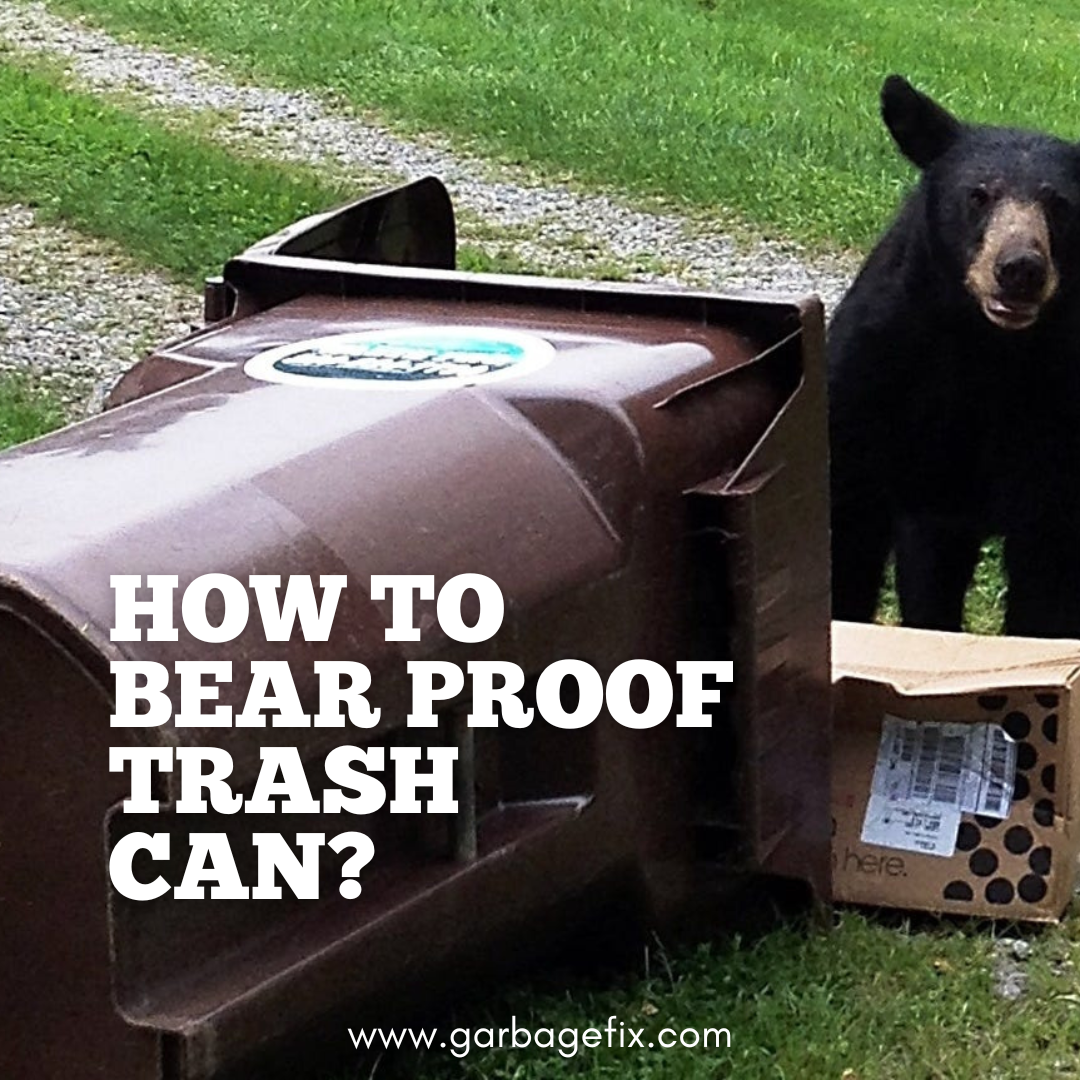Such food may soon become more than just a delight and magnet for animals, particularly bears.Leaving trash out in the open may attract bears and other animals. They are notorious for stepping around neighbourhoods in seek of food. If one of them comes up on any leftovers on the property, it will return for more. So, ensure your garbage can is secure so it doesn't become a bear's favorite snack.
This is not only about bears but also raccoons in a trash can. Raccoons also sniff your trash cans, and they come closer to you and may cause harm. Keep reading us because we are here to provide adequate information to save your lives.
DIY Bear Proof Trash Can - Simple Procedure
As a result of the easy access to human garbage from open garbage cans, bears quickly developed a taste for foods associated with humans. Please use this straightforward do-it-yourself strategy to stop the disruptive behavior of bears and prevent the accidental feeding of bears.
Use A Drill To Make Holes
Hasps fastened to the front, sides of the can, or both. It is recommended that hasps have attachments on both the front and the side for maximum efficiency. Make a mark on the two or three sides of the garbage can that correspond to the locations of the hinged hasps. You will use the drill to create test holes.
Attaching The Hasps
Secure the hasp and latch plate to the can's lid and bottom lip using the appropriate screws. The components are put together by drilling pilot holes in the components, inserting bolts through those holes, and finally, using washers and locking nuts to tighten the bolts.
Lock The Can
To secure the can, thread the clip, quick snap, or carabiner through the latch plate and into the hasp. Use chain, wire, or string to keep clips, quick snaps, or carabiners from falling to the ground or becoming misplaced.
How To Open Bear Proof Trash Can?
- To begin, you will need to insert your finger into the slot provided on the lock.
- Now, pull the trigger all the way back and keep it held.
- Now, firmly grasp the lock with your other hand and pull yourself up.
- Drop the lid until the lock clicks to secure it again.
How To Keep Bears Away From Trash Cans?
Store Your Trash Inside
You should keep trash inside until collection day to avoid bears. A garage shed or another secure building with a locked door is ideal. Since the food incentive is so significant, bears are prepared to work deliberately to get to trash and waste and frequently return in hopes of locating extra. Bears can open basic latches but no locks to get to the rubbish.
Because bears can detect the human scent in food, they will break through the most basic barriers to get to your cans, even if they are hidden from sight. Because of this, it is best to keep all garbage inside. Maintain all food waste indoors until trash day and clean all containers before disposal to minimize outside food smells.
Freeze The Trash
If your trash can stinks, put food scraps in a closed plastic sack and place it in the freezer. Frozen solidity prevents the degradation of the fragments. Once chilled, place the entire bag in the outdoor trash can the night preceding the trash day.
Use Reinforced Trash Cans
Finding garbage cans crafted specifically to withstand the bears' attempts to open them is possible. However, your local garbage collection agency may not accept these containers. Since you probably can't get bear-proof garbage cans, think about fortifying the cans you currently have if you have to store your garbage outdoors.
To keep them from falling over when a bear steps on them, you can lock their lids, secure them to bushes or fencing, or strengthen them with iron bars. These adjustments need not break the bank since most are accomplished by purchasing inexpensive items from a hardware shop.
Build A Protecting Structure
Storing outside trash cans within a bear-proof shed is another option for keeping bears away from your garbage. Trash can cages designed to keep out bears are purchased or constructed relatively easily. Make sure the cans are completely encircled by the construction, both on top and beneath. Normal wooden, vinyl, or chain link fences are readily climbed over or tunneled under by a hungry bear. Regular washing with ammonium or bleach will keep these barriers and the garbage cans within them smelling fresh.
Deterrents For Bears
There are several ways to keep bears from going through your trash cans. You may protect your property against bears by erecting wire fences and training a guard animal, such as a dog, to bark whenever they approach. Also, put up bear-detecting strobe lights, use scarecrows, and do many other things. While these techniques may initially be helpful, bears rapidly adapt and learn to disregard them in their pursuit of food. Preventing bears from eating rubbish at its source, the waste, is nearly usually easier and less expensive than these creative measures.
Prevent Return Visits
Even though seeing a bear on your property is alarming, it may teach you vital lessons about removing the elements attracting bears in the first place. Suppose a bear manages to sneak into your trash. In that case, it is crucial to evaluate its tactics to improve any weak places in your waste collecting and disposal system. If problems continue, you should contact your state's fish and wildlife agency for advice customized to your location.
Is It Recommended A Good Bear-Proof Trash Can?
It is recommended to check with local wildlife authorities or do further research to find the most up-to-date and suitable options for your area. Here are some brands to consider:
- Toter Bear-Tough Carts: Toter is a well-known brand that offers bear-resistant trash cans with durable construction and secure latches.
- BearSaver Trash Cans: BearSaver specializes in producing bear-resistant containers and offers a range of options for residential and commercial use.
- Grizzly Bear-Resistant Products: This brand focuses on producing a variety of bear-resistant containers, including trash cans and food storage solutions.
- Durable Trash Cans with Bear-Proof Modifications: Some companies, such as Bearicuda, offer bear-resistant modifications that can be added to standard trash cans, enhancing their bear-proofing capabilities.
- Local Hardware Stores or Wildlife Authorities: In some regions, local hardware stores or wildlife management agencies might offer information or recommendations on bear-resistant trash cans that are effective for the specific bear species in your area.
When selecting a bear-proof trash can, consider factors such as the level of bear activity in your region, the type of bears present, and the capacity you need. Look for cans with heavy-duty construction, reinforced latches, and tight seals to minimize odors and prevent bears from accessing the contents.
Setting Up a Bear-Proof Enclosure
Setting up a bear-proof enclosure is critical in preventing bears from accessing your trash and other attractants, thereby minimizing the likelihood of bear-human conflicts. Bears are intelligent and resourceful creatures that can become habituated to human food sources, leading to dangerous situations for bears and humans. A bear-proof enclosure is a designated area or structure designed to securely store trash cans, food, and other scented items to keep them inaccessible to bears.
Here's how you can set up a bear-proof enclosure:
- Select a Suitable Location: Choose a location for your bear-proof enclosure that is away from the main living areas of your property but still convenient for you to access. It should be an area with good visibility and lighting.
- Choose an Enclosure Type: You can consider different types of enclosures, depending on your preferences and needs. Some options include:
- Bear-Resistant Storage Shed: A sturdy shed made from materials that bears cannot easily break into. This shed should have reinforced walls, roof, doors, and secure latches.
- Fenced Area: You can create a fenced enclosure using sturdy materials tall enough (usually at least 8 feet high) to deter bears from climbing over. An electric fence can also be added for extra deterrence.
- Enclosed Trash Can Storage Area: If your primary concern is securing trash cans, you can build a smaller, enclosed structure to house your bear-resistant trash cans.
- Construct the Enclosure: Depending on the type of enclosure you've chosen, follow the appropriate construction steps. Ensure that the structure is well-built and can withstand the strength and persistence of bears.
- Secure Entrances and Openings: Doors, gates, and other openings should be reinforced and equipped with bear-resistant locks or latches. These locks should be designed to withstand a bear's opening attempts.
- Implement Electric Fencing (Optional): Electric fencing can be a highly effective deterrent. Install it along the perimeter of the enclosure and around individual storage areas if needed. Make sure to follow safety guidelines and regulations when installing electric fencing.
- Educate Family and Neighbors: Ensure that everyone who accesses the enclosure understands its purpose and how to use it properly. Educate your neighbors about the importance of bear-proofing and encourage them to do the same.
- Regular Maintenance: Inspect the enclosure regularly for wear, damage, or weaknesses. Repair or reinforce any issues promptly to ensure the enclosure remains bear-proof.
- Minimize Attractants: Along with the bear-proof enclosure, minimizing attractants around your property is crucial. This includes properly storing food, bird feeders, and other scented items.
Setting up a bear-proof enclosure creates a safer environment for both bears and humans. It's a proactive step toward responsible coexistence with wildlife and helps prevent bears from becoming habituated to human food sources, ultimately protecting both bears and your community.
Other Bear Deterrent Methods
In addition to setting up a bear-proof enclosure, several other bear deterrent methods can help reduce the likelihood of bear encounters and minimize conflicts between bears and humans. These methods are designed to discourage bears from approaching homes, campsites, or other areas where they might be attracted to food sources. Here are some common bear deterrent methods:
Noise and Light Devices
- Loud noises can startle bears and make them uncomfortable, encouraging them to leave the area.
- Bright lights and sudden noises triggered by motion can deter bears from approaching.
Scent Repellents and Deterrent Spray
- Similar to pepper spray but formulated specifically for bears, bear spray can be used as a last resort to deter an aggressive bear. It temporarily irritates the bear's eyes and respiratory system, giving you a chance to retreat.
- Placing strong-smelling substances like ammonia or bleach around your property can mask food scents and discourage bears from coming close.
Electric Fencing
- These fences emit a harmless electric shock when touched, providing a strong deterrent for bears and other wildlife. Electric fences can protect specific areas like gardens, beehives, or food storage sites.
Food Storage and Handling Practices
- Whether camping or at home, store food in bear-resistant containers or hang it from a tree (in bear country) at a safe distance from sleeping areas.
- Prepare and cook food away from sleeping and camping areas to prevent food odors from attracting bears.
Remove Attractants
- Bears are attracted to bird feeders, so consider removing them during bear-active seasons.
- Thoroughly clean grills after use to remove food residues that might attract bears.
Avoid Leaving Trash Out
- Keep trash secured in bear-resistant containers or inside until it can be properly disposed of.
Educate Others
- Raise awareness in your community about responsible bear-proofing practices and the importance of not feeding bears.
Bear Dogs
- In some cases, specially trained dogs can help deter bears from approaching human areas. These dogs are specifically trained to interact with bears without harming them.
Conclusion
The bears can easily access the trash can in search of food. You can utilize the tricks mentioned above to keep them away from sneaking in. Keep following the Garbagefix for more adventurous tutorials. Removing bears' access to a garbage can reduces the likelihood of an attack and stops bears from growing reliant on human food.








